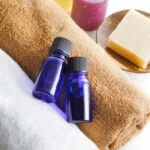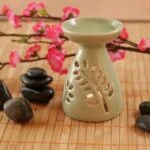Aromatherapy is the practice of using essential oils to promote overall well-being and enhance physical and psychological health. This ancient healing art has been used for centuries, with its origins dating back to civilizations like ancient Egypt, China, and India. By harnessing the power of plants and their aromatic compounds, aromatherapy offers a natural and holistic approach to health and wellness.
The benefits of aromatherapy extend beyond just pleasant scents. When inhaled or applied topically, essential oils can have a profound impact on our mind, body, and emotions. They can help alleviate stress, reduce anxiety, improve sleep quality, boost concentration, soothe headaches, relieve muscle pain, and promote relaxation.
In this article series on how to practice aromatherapy, we will explore the ins and outs of this therapeutic modality. We will guide you through understanding essential oils – their usage and properties – as well as how to choose the right ones for your needs. Additionally, we will delve into safe usage practices and precautions when working with essential oils.
Furthermore, we will introduce you to various methods of practicing aromatherapy including diffusing the oils in your living space or workplace environment. We will also provide tips on how to incorporate aromatherapy into your everyday routine such as during massages or steam inhalations.
By the end of this series, you will be equipped with practical knowledge on how to create your own aromatherapy blends and recipes that suit your unique preferences and goals. Whether you are seeking relaxation or an energizing boost in your daily life, aromatherapy can be a powerful tool for self-care.
Stay tuned as we embark on this aromatic journey together by exploring the wonders of aromatherapy and discovering all its incredible benefits.
Understanding Essential Oils
In order to fully grasp the practice of aromatherapy, it is crucial to understand the role of essential oils. Essential oils are highly concentrated plant extracts that capture the natural fragrance and essence of plants. These oils are obtained through various methods such as steam distillation, cold pressing, or solvent extraction, depending on the type of plant and part being used.
The variety of essential oils available is vast, each with its own unique properties and therapeutic benefits. Some popular essential oils include lavender, peppermint, eucalyptus, tea tree, and lemon. Lavender oil, for example, is well-known for its calming effects and ability to promote relaxation, while peppermint oil can help improve focus and concentration.
When choosing essential oils for aromatherapy, it is important to consider individual needs and desired effects. If you are seeking relief from stress or insomnia, soothing oils like chamomile or ylang-ylang may be beneficial. On the other hand, if you are looking to uplift your mood and increase energy levels, citrus oils such as orange or grapefruit may be more suitable.
| Type | Source | Properties |
|---|---|---|
| Lavender | Lavandula angustifolia | Calming, promotes relaxation |
| Peppermint | Mentha piperita | Focusing, refreshing |
| Eucalyptus | Eucalyptus globulus or Eucalyptus radiata | Cleansing, invigorating |
Quality and purity are essential when choosing essential oils for aromatherapy. Look for oils that are 100% pure, organic, and free from additives or synthetic fragrances. The quality of the oil can greatly impact its therapeutic properties. Avoid purchasing oils that are labeled as “fragrance oils” or “perfume oils,” as these often contain artificial substances and may not provide the same benefits as pure essential oils.
Understanding the different types of essential oils and their properties is key to effectively incorporating aromatherapy into your daily routine. With a wide range of options available, it is possible to find the perfect combinations that cater to your specific needs and preferences. Experimenting with various essential oils will allow you to create personalized blends that enhance your well-being and promote a balanced mind-body connection in practicing aromatherapy.
Choosing the Right Essential Oils for Aromatherapy
When it comes to practicing aromatherapy, choosing the right essential oils is crucial for achieving desired effects and maximizing the benefits of this holistic practice. Each essential oil has its own unique properties and therapeutic qualities, making it important to select oils that align with individual needs and preferences. This section will provide guidance on how to choose essential oils based on specific requirements and desired outcomes.
To begin, it is important to consider personal needs when selecting essential oils for aromatherapy. Whether looking for relaxation, sleep enhancement, stress relief, or concentration improvement, there are specific essential oils that can support these intentions.
For instance, lavender oil is widely known for its calming and soothing effects, making it an excellent choice for those seeking relaxation. On the other hand, peppermint oil is energizing and invigorating, making it suitable for boosting focus and concentration during work or study sessions.
In addition to individual needs, understanding the properties of different essential oils is crucial in making informed choices. Some essential oils are known for their anti-inflammatory properties (e.g., chamomile oil), while others possess antimicrobial or antiviral qualities (e.g., tea tree oil). Knowing the intended purpose of using aromatherapy can help in selecting the appropriate essential oils that serve those purposes effectively.
| Essential Oil | Primary Use |
|---|---|
| Lavender | Relaxation and Sleep Enhancement |
| Peppermint | Focus and Concentration Improvement |
| Lemon | Mood Boosting and Energy Enhancement |
| Tea Tree | Antimicrobial and Antiviral Properties |
| Eucalyptus | Respiratory Health and Congestion Relief |
When it comes to choosing essential oils, it is also important to consider the quality and purity of the oils. Using high-quality, organic, and pure essential oils ensures that you are reaping the maximum benefits from aromatherapy while avoiding potentially harmful additives or contaminants. Look for reputable brands that provide transparent information about their sourcing, extraction methods, and third-party testing.
Overall, choosing the right essential oils for aromatherapy involves understanding individual needs, considering the properties of different oils, and ensuring quality and purity in your selection. By being mindful of these factors, you can create personalized aromatherapy blends that cater to your specific goals and preferences.
Safe Usage and Precautions in Aromatherapy
When practicing aromatherapy, it is essential to prioritize safety and take necessary precautions to ensure a positive experience. Here are some important guidelines to follow when using essential oils for aromatherapy:
- Proper Dilution and Measurement: Essential oils are highly concentrated substances that should never be used undiluted on the skin or ingested. It is crucial to dilute essential oils with a carrier oil, such as jojoba oil or coconut oil, before applying them topically. The recommended dilution ratio for most adults is typically 2-3 drops of essential oil per teaspoon of carrier oil.
- Potential Allergic Reactions and Sensitivities: While rare, some individuals may develop allergies or sensitivities to certain essential oils. Always perform a patch test before using a new essential oil by applying a small diluted amount to the inner forearm and waiting 24 hours for any adverse reactions.
- Contraindications and Cautions: Certain essential oils may have contraindications for specific health conditions or medications. For example, pregnant women should avoid using certain essential oils like clary sage or peppermint. It is crucial to research and consult with a qualified aromatherapist or healthcare professional if you have any underlying medical conditions.
By adhering to these safety measures, you can enjoy the benefits of aromatherapy while minimizing risks.
Different Methods of Practicing Aromatherapy
Methods of Diffusion
One of the most popular and effective methods of practicing aromatherapy is through diffusion. Diffusion involves dispersing essential oils into the air, allowing their aromatic compounds to be inhaled and impacting both the mind and body. There are various ways to achieve diffusion, each with its own benefits and considerations.
Using diffusers
A diffuser is a device specifically designed to disperse essential oils into the air. These devices come in different types, such as ultrasonic diffusers, nebulizing diffusers, and heat diffusers. Ultrasonic diffusers use water and ultrasonic vibrations to break down essential oils into a fine mist, while nebulizing diffusers disperse undiluted essential oil directly into the air as a vapor.
Heat diffusers use heat to evaporate oils but can alter their composition due to the high temperatures. Choose a diffuser that suits your personal preferences and needs.
Vaporizers
Vaporizers work similarly to diffusers by converting essential oils into vapor form for inhalation. These are often used for respiratory issues or creating a therapeutic atmosphere in large spaces. However, it’s important to note that some vaporizers may require dilution of the essential oil before use.
Nebulizers
Nebulizers are another option for direct diffusion without water or heat. They break down essential oils into microscopic particles that can easily be absorbed by the body when inhaled. This method allows for maximum therapeutic benefits as it maintains the purity of the oil.
Other Aromatherapy Techniques
In addition to diffusion, there are other techniques you can explore to practice aromatherapy:
Direct inhalation
Direct inhalation involves adding a few drops of essential oil onto a tissue, cotton ball, or the palms of your hands and then inhaling deeply. This method provides a more immediate and intense experience of the oil’s aroma and can be done on-the-go.
Aromatherapy massage
Aromatherapy massage combines the benefits of essential oils with the relaxing power of touch. During a massage, diluted essential oils are applied to the skin and absorbed through massage techniques. It not only enhances relaxation but also promotes healthy circulation and eases muscle tension.
Steam inhalation
Steam inhalation involves adding a few drops of essential oil to hot water, covering your head with a towel, and leaning over the bowl to inhale the steam. This method is particularly effective for respiratory issues or decongestion.
Benefits and Considerations
Each method of practicing aromatherapy offers its own unique benefits and considerations. Diffusion allows for continuous and passive inhalation, making it suitable for creating a therapeutic atmosphere at home or work. However, some people may find certain oils too strong when diffused undiluted. Direct inhalation is convenient for quick relief on-the-go but may not provide long-lasting effects. Aromatherapy massage combines both topical application and inhalation benefits, but it requires proper dilution to avoid skin irritations.
Consider your personal preferences, lifestyle, and desired outcomes when choosing which method of aromatherapy practice is right for you. Remember to follow safety guidelines, use high-quality essential oils, and consult with a qualified aromatherapist or healthcare professional if you have any specific concerns or conditions.
Incorporating Aromatherapy into Everyday Routine
Aromatherapy has become a popular practice for enhancing overall well-being and creating a soothing atmosphere. Integrating aromatherapy into your daily routine can be a simple and enjoyable way to experience the benefits of essential oils. Here are some practical tips on how to incorporate aromatherapy into your everyday life:
Creating an Aromatherapy Atmosphere at Home:
One of the most common ways to incorporate aromatherapy into your home is by using a diffuser. These devices disperse essential oil molecules into the air, allowing you to enjoy their therapeutic properties throughout your living space. Diffusers come in various forms, such as ultrasonic or nebulizing diffusers. Ultrasonic diffusers use water to disperse essential oils as a fine mist, while nebulizers deliver a more concentrated aroma without water.
Another way to enjoy the benefits of aroma at home is by using homemade room sprays or linen sprays. You can blend your favorite essential oils with water in a spray bottle and use it in any room or on bedding to create a refreshing ambiance.
Incorporating Aromatherapy in the Office:
Aromatherapy can also be beneficial during long hours spent at work. If permitted, place a personal diffuser on your desk with uplifting essential oils like lemon or peppermint to boost concentration and productivity.
If using a diffuser is not feasible, inhaling directly from an essential oil roll-on may provide similar effects. Roll-ons are convenient as they allow you to apply diluted essential oils topically on pulse points for easy inhalation.
Traveling with Aromatherapy:
Even when away from home, you can still enjoy the benefits of aromatherapy during travel. Carry small bottles of travel-friendly essential oils with calming properties like lavender or chamomile that can aid relaxation or promote better sleep while traveling. Inhale these oils directly from the bottle or apply them to a tissue for inhalation.
Also, consider using essential oil inhalers, which are simply portable tubes that hold cotton pads infused with essential oils. These small inhalers can be easily stored in your bag or pocket and used whenever needed.
By incorporating aromatherapy into everyday routines at home, work, or during travel, you can enhance your overall well-being and create a calming environment wherever you go. Experiment with different essential oils and methods of application to find what works best for you.
Aromatherapy Recipes and Blends
Aromatherapy recipes and blends are a great way to personalize your aromatherapy experience and target specific needs or desired effects. Whether you’re looking for relaxation, stress relief, or improved concentration, creating your own blends allows you to tailor the scents to your preferences and needs. Here are some simple and effective recipes to get you started:
1. Calming Blend:
- 3 drops lavender essential oil.
- 2 drops chamomile essential oil.
- 2 drops frankincense essential oil.
This blend is perfect for promoting relaxation and reducing anxiety. Combine the essential oils in a diffuser or dilute them in a carrier oil for a calming massage.
2. Energizing Blend:
- 3 drops peppermint essential oil.
- 2 drops rosemary essential oil.
- 2 drops lemon essential oil.
When you need a boost of energy and mental clarity, this blend is your go-to. Use it in a diffuser, add it to bathwater, or mix it with a carrier oil for an invigorating body lotion.
3. Focus Blend:
- 3 drops grapefruit essential oil.
- 2 drops basil essential oil.
- 2 drops peppermint essential oil.
If you need help staying focused and alert during work or study sessions, this blend can improve concentration. Diffuse it in your workspace or wear it as a personal inhaler during tasks that require mental focus.
To prepare these blends, simply combine the indicated number of drops for each essential oil into an appropriate container (such as a glass bottle or rollerball). Shake well before each use to ensure the oils are thoroughly mixed. Remember to always store your blends in a cool, dark place to preserve their potency.
It’s important to note that everyone’s scent preferences may vary, so feel free to experiment with different combinations until you find the perfect blend for you. Aromatherapy is a personal journey, and creating your own recipes can be a fun and rewarding part of the experience. So don’t be afraid to get creative and try new combinations that resonate with you.
In addition to these specific recipes, there are endless possibilities for creating your own aromatherapy blends. You can mix oils based on their therapeutic properties or simply select scents that you find appealing. The key is to listen to your body and intuition when selecting essential oils, as they can have different effects on different individuals.
By exploring the world of aromatherapy recipes and blends, you can truly customize your aroma-sensory experience and enhance your well-being in various aspects of life.
Aromatherapy and Self-Care Practices
Aromatherapy is not just a method of enhancing the ambiance or scent in a room, but also a powerful self-care practice that can promote relaxation, mindfulness, and overall well-being. Incorporating aromatherapy into your self-care routine can help create a sense of calm and balance in your daily life. By combining the therapeutic benefits of essential oils with intentional self-care practices, you can maximize the positive effects on your physical and mental health.
When practicing aromatherapy as part of your self-care routine, it’s important to approach it with intention and awareness. Before you start using essential oils, take a moment to set an intention for your self-care session. This could be anything from relieving stress or anxiety to promoting better sleep or boosting your mood. By setting an intention, you are directing the energy and focus of your practice towards a specific goal.
One effective way to incorporate aromatherapy into your self-care routine is by coupling it with complementary practices such as meditation or yoga. The combination of aromatic scents with these mindful activities can deepen their impact. For example, you can enhance your meditation practice by diffusing calming essential oils like lavender or chamomile to create a peaceful environment. Similarly, incorporating invigorating essential oils like peppermint or eucalyptus during yoga sessions can help increase focus and energize the mind and body.
Conclusion
In conclusion, aromatherapy offers a wide range of benefits for both the mind and body. By harnessing the power of essential oils, individuals can experience improvements in their psychological and physical well-being. Whether it’s promoting relaxation, improving sleep quality, enhancing concentration, or reducing stress, aromatherapy provides a holistic approach to self-care.
Throughout this article, we have explored the different aspects of aromatherapy, from understanding essential oils to choosing the right ones for specific purposes. We have discussed safe usage and precautions to ensure the effective and responsible application of essential oils. Additionally, we have delved into various methods of practicing aromatherapy and shared practical tips on incorporating it into everyday routines.
By experimenting with aromatherapy recipes and blends, individuals can personalize their practice according to their unique needs and preferences. Furthermore, when combined with other self-care practices like meditation or yoga, aromatherapy becomes a powerful tool for enhancing overall well-being.
In essence, aromatherapy is an accessible and versatile practice that anyone can enjoy. It has the potential to improve mood, reduce stress levels, enhance mental clarity, and provide numerous other benefits. So why not start incorporating aromatherapy into your life today? Explore different essential oils, experiment with blends and diffusion methods, and create your own personalized rituals. Embrace the world of aromatherapy and reap its countless rewards for your mind, body, and soul.
Frequently Asked Questions
How can I practice aromatherapy at home?
Aromatherapy can be easily practiced at home with a few simple steps. First, gather your preferred essential oils, such as lavender for relaxation or eucalyptus for congestion relief. Then, choose an appropriate method of diffusion, such as a diffuser, room spray, or even adding a few drops to a warm bath.
Create a relaxing ambiance by dimming the lights, playing soft music if desired, and ensuring a comfortable space to fully enjoy the aromas. Start by inhaling deeply and allowing yourself to be present in the moment while taking in the scents. It’s also beneficial to research and understand each oil’s effects and safety precautions before use.
What qualifications do you need to practice aromatherapy?
In order to practice aromatherapy professionally and offer services to others, several qualifications are typically required. These qualifications may vary depending on the jurisdiction and specific regulations, so it’s important to research the requirements of your location. Generally, a recognized certification or diploma in aromatherapy is recommended.
This certification often covers various essential oil extraction methods, understanding different plant essences, contraindications and safety measures, blending techniques, and client consultation skills. Additionally, having knowledge in anatomy and physiology can be beneficial in order to fully understand how essential oils interact with the body.
How often should you practice aromatherapy?
The frequency of practicing aromatherapy largely depends on personal preference and individual needs. Some individuals may benefit from daily aromatherapy sessions while others may find occasional use more suitable for their lifestyle or health goals. Regularly incorporating aromatherapy into self-care routines can provide consistent benefits such as stress relief or improved mood over time.
However, it’s important to remember that essential oils are concentrated substances and should always be used with caution and respect for their potency. Pay attention to any adverse reactions or sensitivities and adjust frequency accordingly. Consulting with a certified aromatherapist may also help determine an appropriate frequency based on individual circumstances or health concerns.

Are you looking for a natural way to improve your health and wellbeing?
If so, aromatherapy may be the answer for you.





